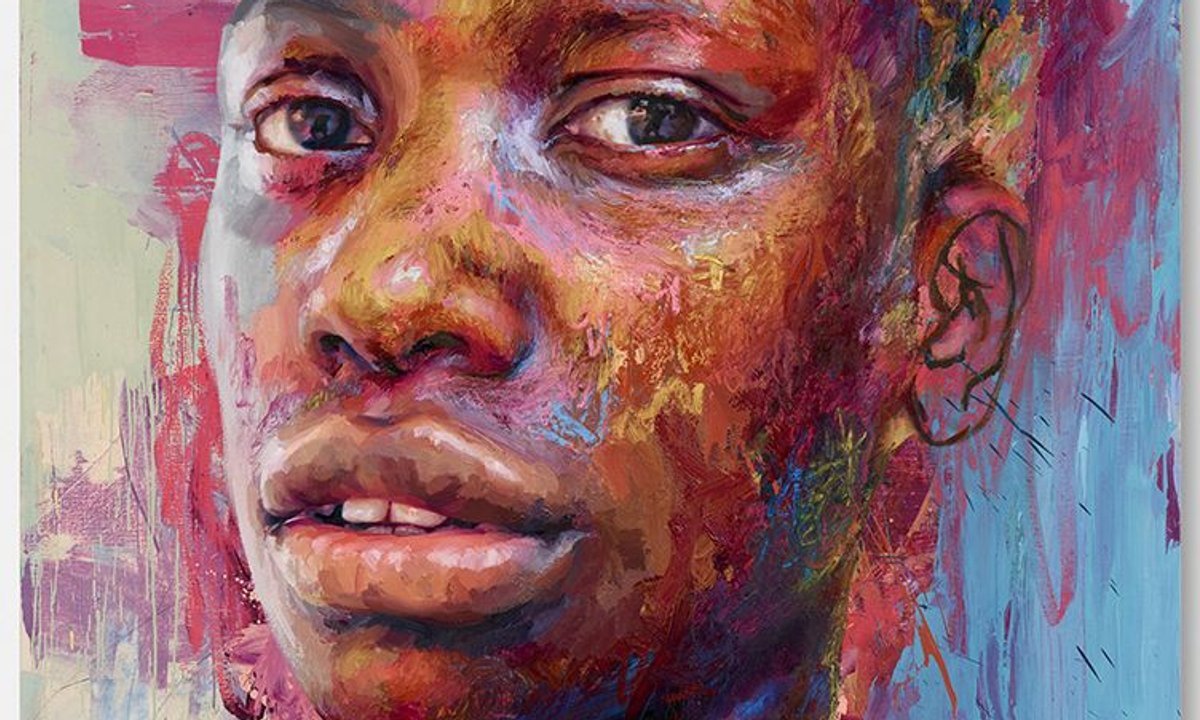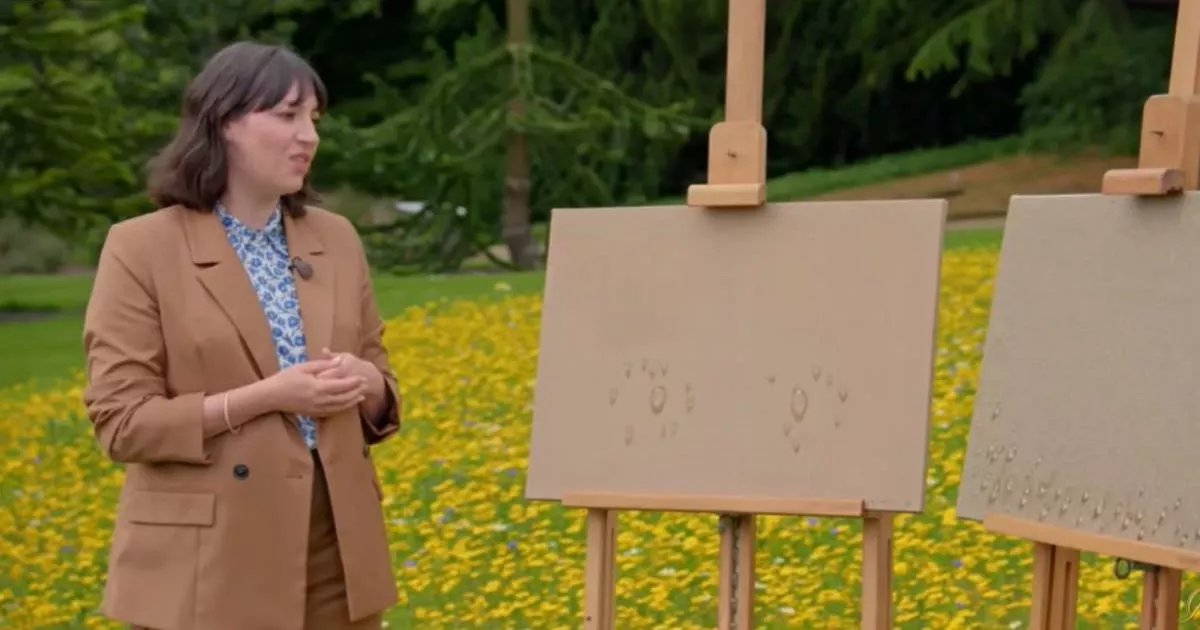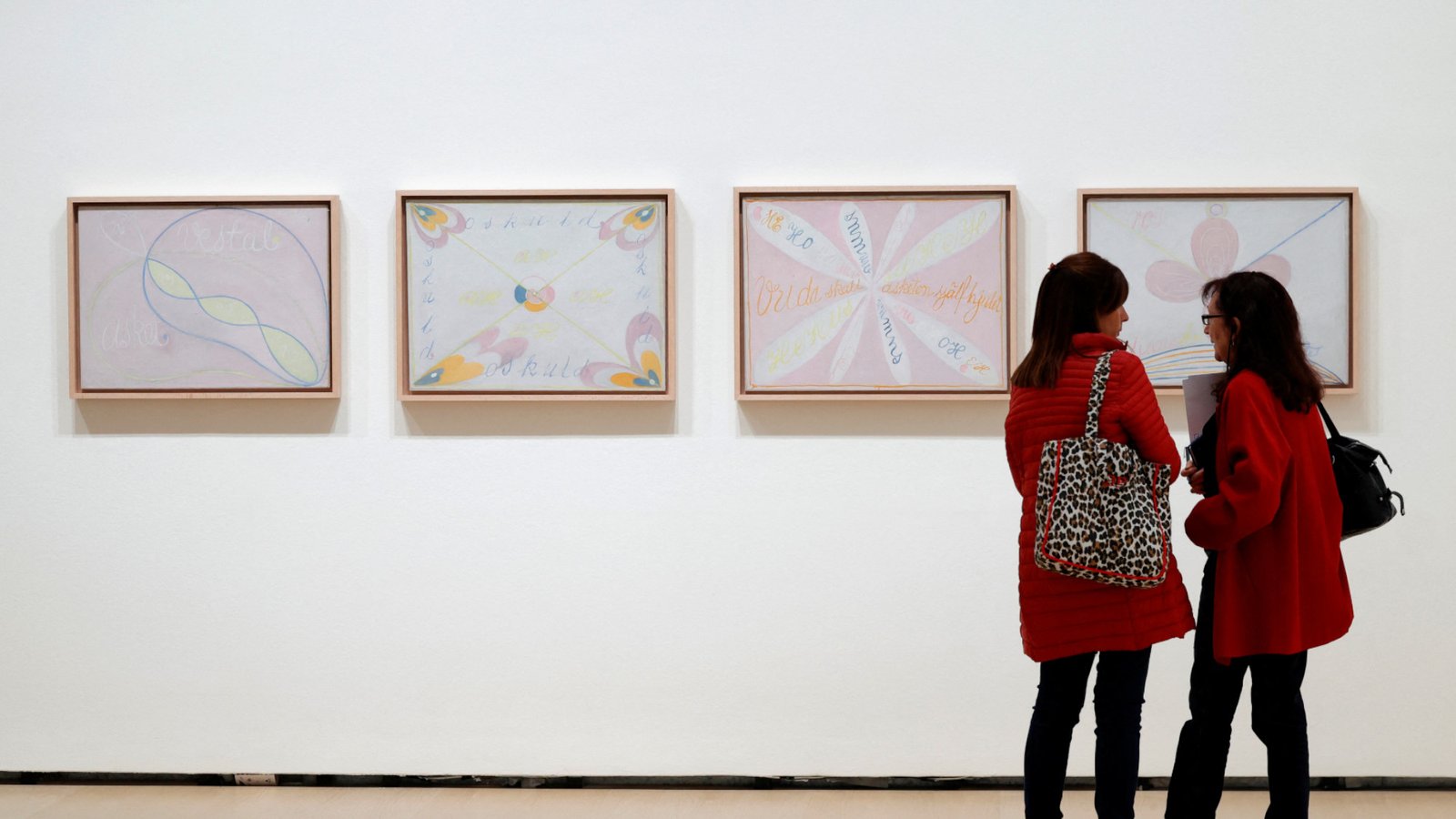‘I’m a mortician,” says Robert Longo, 71, clad in black and sporting a luxuriant grey bouffant. “I have an idea, then kill it by making it. Then I dress it for a funeral.” This may seem a strange way to describe your first British solo exhibition in seven years, but Longo’s “job” is even weirder than that. After he’s arranged the funeral, he has to do the eulogy, telling the media why what he’s done is worth seeing.
We’re sitting in the Thaddaeus Ropac gallery in Mayfair, London, before the corpse. In front of us is Untitled (Pilgrim), a multimedia installation consisting of five huge panels. Longo’s conceit is that each image has the same proportions as a mobile phone screen. “You swipe right through each image,” he explains. Its size suggests that Longo remains true to his mentor, sculptor Richard Serra. “Richard taught me in the 1970s and whenever I would see him later he’d say, ‘Still making big art?’”
The first panel is a photorealist charcoal drawing of a sculpture: Saint Teresa writhing in ecstasy in Bernini’s Roman altarpiece. Longo first saw it in the early 1970s after quitting his internship as an art restorer in Florence. Its erotic charge stayed with him. “Bernini didn’t spend much time on the drapery,” Longo says. “You can see he spent more time and effort on getting her expression just right. Look at the tilt of her head, exactly the right angle for the ecstasy he wants to express.”
Longo has long been interested in how the human form twists and bends. His breakthrough works, Men in the Cities (1977-83), were vast suites of drawings of writhing people, based on photographs he took of friends in New York dressed to resemble suited Wall Street drones. He cites as influences 1970s New York punk band James Chance and the Contortions, Michelangelo’s slave sculptures and the way, in Sam Peckinpah movies, shot bodies would get blown through doors.
Men in the Cities has since become iconic. In the 2000 film adaptation of Bret Easton Ellis’s American Psycho, three Men in the Cities hang on the Manhattan apartment walls of yuppie serial killer Patrick Bateman. “I had a bit part in the movie,” Longo chuckles.
In 2009, Longo visited New York’s Metropolitan Museum to see The Pictures Generation, a retrospective about a group of American artists – including Richard Prince, Cindy Sherman, Barbara Kruger and Longo – feted for critically analysing media culture. In the lobby were three framed images from Men in the Cities. “My son’s girlfriend asked me if I got the idea from iPod ads. I said I did them 30 years before the iPod was invented.”
Back to Ropac. Next to Saint Teresa is a raging fire trapped behind bars. The next panel is a painted riff on a vulgar Chanel necklace. “I bought the New York Times and it came in a wrapper advertising that necklace,” Longo says. “You had to get through the luxury ads to get to the news.”
Next is a bronze bundle of branches, composed from scans of twigs found in his East Hampton garden. “I had a stroke a few years ago and the doctor showed me my brain scans. They looked like these twigs.” The final panel is a close-up of a melting iceberg taken from the internet. My theory is the psychotic fire from panel two is responsible for this panel’s climate crime. The panels, he says, are in sequence. “It’s like a series of power chords, or guitar riffs.” He calls this installation a combine, a term coined by Jasper Johns to describe Robert Rauschenberg’s hybrid works from the 50s and 60s.
When Longo made his old combines in the 80s, smartphones weren’t around. His new combines suggest we have degenerated from homo sapiens to what philosopher Byung-Chul Han recently called phono sapiens, endlessly image-hunting through infinite databases. Or, to put it another way, his new work indicates how the pandemic prophesied in the Keanu Reeves-fronted 1995 cyberpunk movie Johnny Mnemonic, adapted by Longo from a William Gibson story, has come true. Today, humans are suffering from a malady the script called the “black shakes”. The film proposed that by 2021 tech-fixated humans would be made ill by overexposure to electronic devices. “What can I say?” says Longo. “We saw the future.”
We stroll to Pace gallery where the second part of Longo’s exhibition awaits, which includes another five-panel combine. I find myself looking at a charcoal drawing of a flower, a small drawing of political resonance and a film. In fact, as we enter, I’m confronted by Reeves as ageing hitman John Wick, barrel of his Glock targeted on my face. This is the first image of Untitled (Searchers).
“He’s the sweetest guy,” says Longo of Reeves, whom he met while filming Johnny Mnemonic and who recently collaborated with Longo and Gibson to make a publicity video for a black-and-white version of the much-derided picture. “He’s godfather to my son, who was born when we were making the movie.” Longo has three sons by his ex-wife, German actor Barbara Sukowa. In 2022, he married film-maker Sophie Chahinian, with whom he became romantically linked after she came to interview him.
“Keanu plays bass in a band, but nothing like Johnny Depp. He just stands stage left, not hogging the spotlight.” Longo is also a musician: he played guitar in a band called Menthol Wars with Richard Prince during the 1980s. Later, in the X-Patsys, he accompanied Sukowa singing Patsy Cline and Johnny Cash covers in her charming German accent.
New York Times critic Roberta Smith once dubbed Longo “Robert Long Ago” as if to suggest his irrelevance to the art zeitgeist. Longo quotes a line from John Wick in which Reeves’s hitman says: “People keep asking me if I’m back, and I haven’t really had an answer. But now, yeah, I’m thinking I’m back!” Longo, too, thinks he’s back. “I’m making my best work ever. Every morning I leap out of bed to go to the studio. I’m obsessed.”
after newsletter promotion
Despite all the big art that Longo has made for London, it is two little drawings that most captivate me. At Ropac, there’s a tiny charcoal copy of a press photograph depicting a middle-aged woman’s hands holding a photograph to the camera. The photograph is of Mahsa Amini, who died in 2022 after being arrested and reportedly beaten by Iran’s morality police for not covering her hair. At Pace, there is a small drawing of hands clutching a photograph of another victim of an authoritarian state, Russian opposition leader Alexei Navalny, who died in February.
Longo has been sensitive to such state killings ever since 1970, when the Ohio National Guard shot and killed four students during an anti-Vietnam war demonstration at Kent State University. One, Jeffrey Miller, had been Longo’s school friend in Long Island. In John Filo’s Pulitzer-winning photo, Miller is depicted face down on the pavement as a distraught young woman crouches over him. “It still haunts me,” Longo says. Of the many images he has seen in his life, this was one that he felt unable to appropriate for his own art.
That image helped him see art as a kind of social activism, spurring us to see what goes unseen even though it’s right in our faces. In 2014, Longo was struck by how demonstrations protesting against the shooting of 18-year-old African-American Michael Brown in Ferguson, Missouri, were policed. “News photos made it looked like Ukraine or some war zone. Then I saw an Exxon sign and realised it was America. All these cops were wearing military gear that was surplus after Afghanistan.”
In response, he made Untitled (Ferguson Police August 13 2014), a 10ft-wide charcoal drawing of a line of helmeted, faceless cops, silhouetted against searchlights in a swirl of illuminated smoke. The image captured, as the Guardian’s Jonathan Jones wrote, not just the return of racism, but how the threat of state violence underpins allegedly free societies. “You know what gets me up in the morning making art?” asks Longo. “Rage. Rage and helplessness.”
Since then much of Longo’s work has raged against American violence. In 1993 he made Death Star, consisting of 18,000 rounds of ammunition suspended in a sphere. It evoked the 18,000 American gun casualties the previous year. In 2018, he updated that sculpture, this time using 40,000 bullets – roughly the number of gun casualties in 2017. This orb hung from an I-beam at Art Basel – a mirrorball for a death-themed disco. “It’s more about creating some kind of beauty out of something horrible,” he said then, “and at the same time hoping that it will make you personally think, ‘What am I going to do about this?’”
Finally, Longo takes me to the gallery basement. A screen filling one wall shows an unstoppably fast-paced montage of news images from one day, 4 July, this year. One-time surfer Longo is here riding a tsunami of news. What we see, though, is a blizzard of images, history accelerated into incomprehensibility. “It almost becomes abstract,” Longo says as we stare. “People said the abstract expressionists were really figurative artists. I’m a figurative artist whose work becomes abstract.”
As he speaks, the blizzard suddenly halts on certain images: Keir Starmer speechifying; Trump bloviating; Hezbollah fighters in fatigues clutching assault rifle flags. How do you decide on which image to stop the film? “I don’t. An algorithm decides and stops randomly.”
How fitting and chilling. Before our eyes, humans are dissolving into abstraction just as the artist’s hand is supplanted by machine intelligence. Longo truly is a mortician, presiding over not just the death of art – but also of our species.






